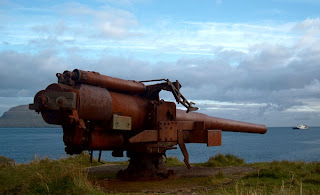
HOLMSTROM
C.O.W.1916
No.42 No.42 is one of the two big 20th century guns at Fort Tórshavn (Skansin). (The other one is no.35)


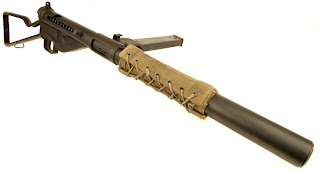

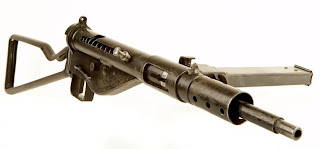


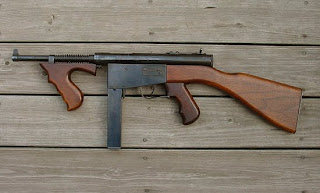
| Caliber | 9x19mm, .38 Super and .45 ACP |
| Weight | ~3,3 kg empty |
| Length | 762 mm |
| Barrel length | 228 mm |
| Rate of fire | 600 rounds per minute |
| Magazine capacity | 30 rounds |
| Effective range | 100 meters |

 Star RU-35 submachine gun, close-up view on the controls (fire mode selector, left, and rate of fire selector, right)
Star RU-35 submachine gun, close-up view on the controls (fire mode selector, left, and rate of fire selector, right) | Caliber | 9x23 Largo |
| Weight | 3.74 kg |
| Length (stock closed/open) | 900 mm |
| Barrel length | 269 mm |
| Rate of fire | 300 or 700 rounds per minute |
| Magazine capacity | 10, 30 or 40 rounds |
This submachine gun was developed by mid-1930s by famous Spanish arms-making company Bonifacio Echeverria SA, which operated under the trademark "Star". There were three slightly different model in the 1935 Star line of submachine guns: the RU-35, which had slow rate of fire of about 300 rounds per minute, the TN-35, which had fast rate of fire of about 700 rounds per minute, and the SI-35, which has dual (selectable) rate of fire. Otherwise all three weapons were similar, sharing same layout, same complicated delayed blowback action, and same overly complicated controls setup, consisting of two multi-position levers on the left side of the receiver. These submachine guns were manufactured in Spain and used by Guarda Civil. During the WW2, a version of this submachine gun was tested in USA and UK under the name "Atlantic", but was rejected on the grounds of the complexity and excessive costs of manufacture.
Star RU-35 / SI-35 submachine gun utilizes delayed (retarded) blowback operation, using two-part bolt with special locking piece, which temporary locks the bolt head to the receiver upon the early stages of recoil. Gun fires from open bolt, in full and semi-automatic modes. The SI-35 version has additional rate of fire reducer which is controlled by the rear switch on the left side of the receiver (it also doubles as a safety). Forward switch controls modes of fire (semi-automatic or full automatic). Feed is from detachable box magazines, which were supplied in various capacities. Rear sight was adjustable for range from 50 and up to very optimistic 1000 meters range. Gun was fitted with wooden stock, barrel was enclosed into slotted jacket, which also carried muzzle brake - compensator and a bayonet lug.

| Caliber | 9x23 Largo |
| Weight | 3.87 kg |
| Length (stock closed/open) | 580 / 841 mm |
| Barrel length | 192 mm |
| Rate of fire | 450 rounds per minute |
| Magazine capacity | 10 or 30 rounds |
The Star Z-45 submachine gun was developed in Spain by famous arms-making company Bonifacio Echeverria SA toward the end of the World War 2. It can be considered as an improved and refined version of the famous German MP40 submachine gun. The Star Z-45 submachine gun turned to be a robust and reliable weapon, and it successfully served with Spanish army and police for several decades after WW2. It was also exported to some South and Central American and Asian countries.
Star Z-45 submachine gun is based on simple blowback action, firing from open bolt. The bolt / return spring / telescoped guide setup is based on MP40. Z-45 also has similar safety arrangements ( laterally sliding bolt handle that locks the bolt when pushed inwards, plus L-shaped cut in the bolt handle slot to lock the bolt in rearward position). The Star Z-45 submachine gun can fire in single shots or full automatic, with selection being made through the pull of the trigger (short pull produces single shots, long pull - full automatic fire). Gun is fitted with wooden pistol grip and forend, and with bottom-folding metallic buttstock (all patterned after the MP40). The barrel is enclosed into slotted jacket, with muzzle brake - compensator at the front. The flip-up backsight is of L-shaped profile, with settings for 50 and 100 meters.
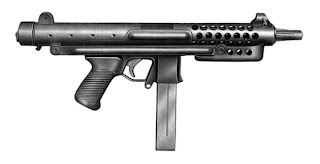
The Star Z62 submachine gun was developed by STAR Bonifacio Echeverria SA company of Spain circa 1962, and was adopted by Spanish army, police and Guarda Civil in 9mm Largo. For export it was offered in more common 9mm Luger/Parabbelum chambering. In the 1971 Star company came with updated version of Z62, called Z70b. This gun had minor modifications, described below, and also was manufactured in 9mm Largo for Spanish service and in 9mm Luger for export. In Spanish army it was replaced in mid-1980s by the Star Z84.
Star Z62 is a conventional blowback operated, selective fire submachine gun. The tubular receiver in its front part also acts as a heatshield, the cocking handle is located at the left side and does not move when gun is fired. The firing pin is mounted within the massive cylindrical bolt and is operated by lever, which protrudes from the bolt and moves the firing pin off the bolt face only when bolt is its forwardmost position. Another intersting feature is a two-finger trigger, which also acts as a fire selector, depending on what part of the trigger (upper or the lower) user pressed. The safety was of cross-bolt type. The metallic buttstock folds under the gun when not in use and can be used as a handguard. Rear sight has flip-up "L"-shaped blade with two settings, for 100 and 200 meters.
Z70b is in most aspects similar to the Z62, but it utilises more conventional safety / fire selector switch above the triggerguard and a conventional trigger, and also has magazine catch of different type.

Caliber: 9x19mm Luger/Para
Weight: 3.0 kg without magazine
Lenght (stock closed/open): 410 / 615 mm
Barrel lenght: 215 mm
Rate of fire: 600 rounds per minute
Magazine capacity: 25 or 30 rounds
Effective range: 150-200 meters
Z-84 submachine gun has been developed in mid-1980s by Star Bonifacio Echeverria SA company of Spain, as a compact, lightweight yet comfortable and powerful weapon. Unlike its predescessors, the Z-62 and Z-70B, Z-84 available only in 9mm Luger/Parabellum (some sources said that it can be orederd in 9mm Largo, however) and is adopted by some Spanish Army and police units, and also is sold for export.
Z-84 is built to modern standards, having stamped steel, two-piece receiver, with magazine housing built into the pistol grip. The bolwback-operated bolt is of wrap-around type, and when in forward position, it sleeves around the barrel for most part of its lenght. Bolt rides on two guide rails and has significant clearance between its sides and receiver walls, allowing the mechanism to work when seriously fouled inside. Z-84 fires from the open bolt, and has feed system so deigned that it allows for reliable feeding not only of FMJ ammunition, but also Soft-Point and HollowPoint (JSP, JHP) ammunition, used in police operations to achieve better stopping power. Safety switch is located inside the triggerguard, behind the trigger, and locks the trigger when engaged. Separate fire mode selector is located at the left wall of the receiver and allows for single shots or full-auto fire. Z-84 has additional safety features, including "intercepting notches" on the bolt, that used to catch the bolt if charging handle slips from the hand during the chargng cycle. Also, it has special "inertia lock", that locks the bolt in forward position against hard blows, and is owerridden by the pull of the charging handle. The charging handle itself does not move when gun is fired. Two-position flip-up aperture rear sights are graduated for 100 and 200 meters distance. Folding metallic butt-stock flips up and forward when not in use.
According to some sources, Z-84 is very reliable and quite controllable in full-auto, even when fired off-hands.
 SKORPION EVO III submachine gun
SKORPION EVO III submachine gun| Caliber | 9x19mm Luger / Parabellum |
| Weight | 2.1 kg empty |
| Length (stock closed/open) | 400 / 650 mm |
| Barrel length | 196 mm |
| Rate of fire | 1100 rounds per minute |
| Magazine capacity | 20 or 30 rounds |
SKORPION EVO III submachine gun is a most recent product of the famous Czech small arms manufacturer Česka Zbrojevka Uherski Brod (CZ-UB). This weapon began its life in Slovakia in around 2002, as the Laugo submachine gun / personal defense weapon. Once the design became mature, it was sold to CZ-UB, which brought it to public attention in 2009 as SKORPION EVO III submachine gun. It seems that this weapon is targeted for police market, but it also can found some use by certain military units. An export version of the SKORPION EVO III submachine gun is also proposed, chambered for .40SW ammunition which is very popular as a police round in USA and certain South American countries.
SKORPION EVO III submachine gun is a simple blowback operated, selective fired weapon that fires from closed bolt. It has a separate hammer unit, with ambidextrous safety / fire mode selector, that offers single shots, 3-round bursts and full automatic fire modes. The charging handle is located on the left side of the gun, above the forend. The receiver, pistol grip / trigger unit and the forend all are made from polymer. The side-folding shoulder stock is also made from polymer, and can be adjusted for length of pull due to telescopic design. Iron sights are installed on removable bases, using integral Picatinny type rail on the top of receiver. Additional sighting equipment can be added using this same rail; three more accessory rails are installed at the sides and bottom of the forend. Feed is from detachable box magazines, made of semi-translucent plastic, that hold 20 or 30 rounds of ammunition.
 Villar-Perosa M1915 twin-barrel submachine gun on the one-man portable "tray" mount, used by mountain troops. Photo from Austrian army museum, Vienna
Villar-Perosa M1915 twin-barrel submachine gun on the one-man portable "tray" mount, used by mountain troops. Photo from Austrian army museum, Vienna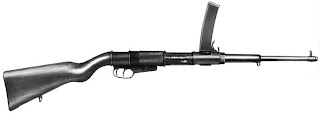
| Villar-Perosa M1915 | Villar-Perosa M1918 | |
| Caliber | 9x19mm Glisenti | 9x19mm Glisenti |
| Weight, empty | 6.5 kg (less mount) | 3.6 kg |
| Length (stock closed/open) | mm | 902 mm |
| Barrel length | 279 mm | 279 mm |
| Rate of fire | 2 x 1200 - 1500 rounds per minute | 900 rounds per minute |
| Magazine capacity | 2 x 25 rounds | 25 rounds |
The Villar Perosa submachine gun is one of the most unusual weapons that emerged during the WW1. The name of the weapon comes from the name of the company that manufactured these guns, the Officine Villar Perosa (OVP in short). This gun was originally designed in 1914 by famous Italian small arms designer Bethel Abiel Revelli as an aircraft weapon. In this role it found no success, as it was designed to fire low-powered 9mm Glisenti ammunition, which was even weaker than dimensionally similar 9x19 Luger ammunition. In 1915 the Villar-Perosa was converted for ground applications, with introduction of variety of mountings, including light tripods or carrying trays (which were carried on shoulder straps or put on the ground for more stable position and less exposure to enemy fire). Later on, a wooden rifle-type stock was designed for Villar-Perosa, so it could be fired more or less comfortable from the shoulder, thus creating the first practical submachine gun in the world. After the war, some of the original Villar-Perosa weapons (which were actually assemblies of two similar guns) were disassembled into halves, and put into rifle type stocks, with addition of the rifle-type triggers. Such conversions were known as Villar Perosa OVP M1918 (when done by Villar Perosa). A slightly improved version of the same design was also produced by Beretta company, and it was known as Beretta M1918.
The Villar Perosa M1915 weapon was assembled from two guns of exactly same design and appearance, which were held together by the plate at the front of the receiver and by the twin spade grips assembly at the rear. Each gun has its own trigger, operated by a separate thumb button between spade grips. The guns themselves used delayed blowback action, in which the delay of the initial opening of the bolt was achieved by rotation of the bolt through the bolt handle that slid against the inclined part of the cocking handle slot. The bolt rotation, combined with separate firing pin, provided safety measure against premature ignition of the cartridge, as the firing pin was able to go forward and strike the primer only when bolt was in battery and completely rotated. Guns fired from open bolt, in full automatic mode only. Due to the lightweight bolt and powerful springs, the rate of fire was excessively high for the ground applications, being between 1200 and 1500 rounds per one gun (rising up to 3000 rounds per minute when both guns were fired at once). The feed was from detachable box magazines, holding just 25 rounds each, so one magazine was forth just one second of the continuous fire. Magazines were inserted into the each gun vertically from the top, ejection was to the bottom. Sights were located between the guns, with rear sight being built into the spade grip assembly and the front sight into the front plate that held both guns together.
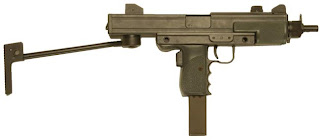
| Caliber | 9x19mm Luger / Parabellum |
| Weight | 2.45 kg empty |
| Length (stock closed/open) | 400 / 600 mm |
| Barrel length | 200 mm |
| Rate of fire | 550 rounds per minute |
| Magazine capacity | 32 rounds |

| Caliber | 9x19mm Luger / Parabellum |
| Weight | 3,7 kg empty |
| Length (stock closed/open) | 526 / 790 mm |
| Barrel length | 200 mm |
| Rate of fire | 400 rounds per minute |
| Magazine capacity | 10, 20, 32 or 40 rounds |

The Uzi Pro is an evolution of the Micro-Uzi submachine gun. It retains same blowback operated, closed bolt, select-fire action but with side-mounted bolt handle, and the most important change is replacement of the older stamped steel trigger housing with more lightweight polymer pistol grip / trigger housing unit of more ergonomic shape. Top of receiver is provided with parmanently attached Picatinny rail, which is used to install various sights (i.e. Red Dot sights). Additional Picatinny rails are provided on the sides of the barrel and below it (the bottom rail is covered with ergonomically shaped protector when not in use). All firing controls are the same as with Micro-Uzi and include side-mounted safety / fire selector, automated grip safety (of improved shape) and magazine latch. Uzi Pro submachine gun uses same magazines as other weapons of the Uzi family, with 25-round ones being standard.


Caliber: 4.6x30mm HK
Weight: 1.5 kg empty
Length (stock closed/open): 340 / 540 mm
Barrel length: 180 mm
Rate of fire: 950 rounds per minute
Magazine capacity: 20 or 40 rounds
Effective range: 150-200 meters







In addition, the more powerful the gun and ammo are, the more chance the bullet will travel at supersonic speed and produce that loud ballistic crack. A high-powered, supersonic bullet can’t be completely silenced because it has literally created a tiny sonic boom as it travels from the barrel.
To illustrate these phenomena, forensic researchers used a special imaging camera. The man in the photo below has discharged a .44 Magnum revolver. Two spherical shock waves are seen. One is a bright flash and cloud of gunpowder combustion centered at the gun’s muzzle (the muzzle blast); the other is centered near the cylinder and envelops the hands of the shooter (around the body of the gun and chamber/cylinder). The supersonic bullet is visible at the far left. This kind of split-split-second photography helps forensics experts understand the transfer of gunpowder traces to the hands when firing a gun. It also allows us to “see” the muzzle flash, the gases exploding out, and the flight of the bullet, all of which aren’t ordinarily visible to the naked eye.

You’ve all seen TV shows and movies where assassins use silencers, the devices that screw onto the end of a gun and render the gun noiseless. Noiseless? Yeah, right. A better name would be “suppressor” because there is no such thing as completely silencing the sound of a gun firing. However, people tend to use the terms interchangeably.
A fired gun makes a combination of sounds: 1) the hammer or striker being released makes a clicking sound; 2) the muzzle blast; and 3) the ballistic crack we hear as the bullet is propelled out. All of those sounds seem to happen almost simultaneously, but it’s the latter two that are the loudest.



